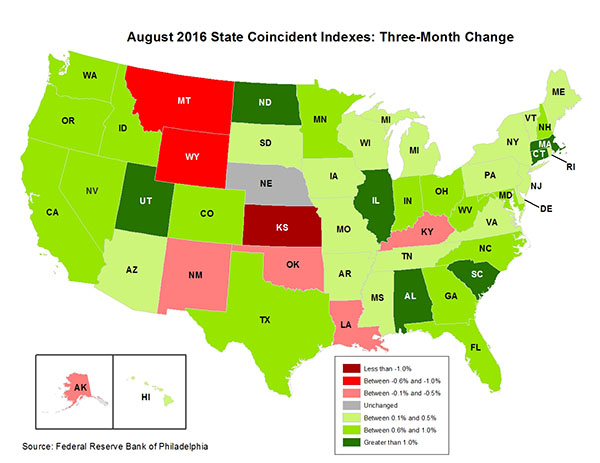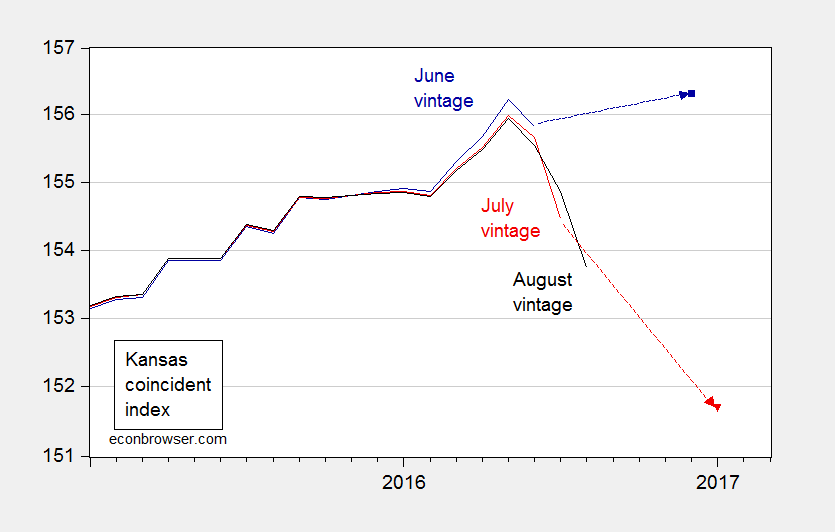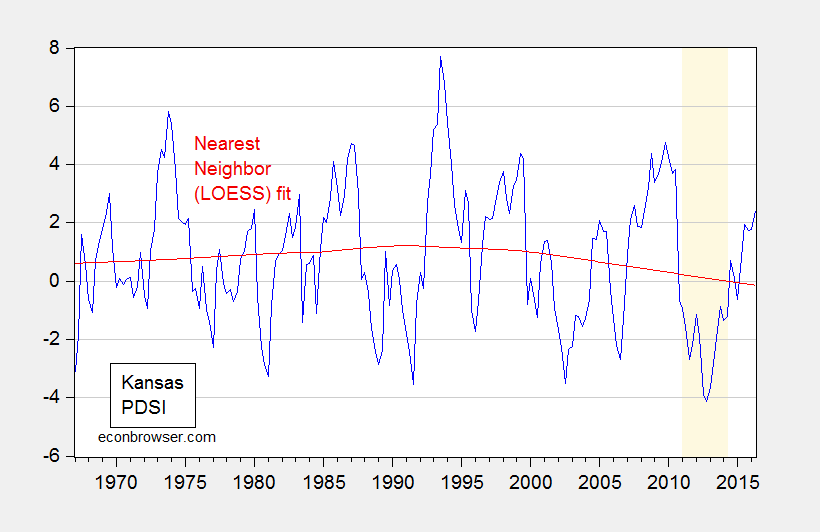No more drought in Kansas. And yet, according to the Philadelphia Fed, Kansas again stands out in economic decline:
Source: Philadelphia Fed.
The August figures in the context of previous vintages, and forecasts, are shown below:
Figure 1: Kansas coincident index, June vintage (dark blue), July vintage (red), August vintage (black); December 2016 and January 2017 values are implied by leading indices; all on log scale. Source: Philadelphia Fed and author’s calculations.
While the July index value has been revised upward by 0.3 percent (log terms), the trajectory of economic activity remains largely unchanged.
This downturn is all the more remarkable given the improvement in the drought conditions.
Figure 2: Kansas Palmer Drought Severity Index (blue, left log scale), log Kansas coincident index (black, right scale, 2016M05=0), log civilian employment (red, right scale, 2016M05=0). Source: NOAA, Philadelphia Fed, BLS, and author’s calculations.
For those who are concerned that the Philadelphia Fed’s coincident index misrepresents economic activity in Kansas (despite the fact that the correlation between state GDP and coincident indices is between 0.55-0.70, according to the Philadelphia Fed), I’ve included reported civilian employment; that too has collapsed since its most recent peak: about 2% (log terms) in the space of five months.
And that recovery in drought conditions is from an overall worsening trend.
Figure 3: Kansas Palmer Drought Severity Index (blue), and Nearest Neighbor (LOESS) fit, bandwidth=0.7 (red). Down indicates greater drought conditions. Quarterly data average of monthly data. Light tan shading for period 2011Q1-2014Q2. Source: NOAA, author’s calculations.
Since about 1998, the trend has been toward lower values of the PDSI.
Update, 9/25, 4pm Pacific:




Are you sure it’s not because the Munchkins found work hard to find in KS and returned home to Oz?
Btw, I guess Jeff Frankel will have a bone to pick with this guy:
http://etfdailynews.com/2016/09/21/gallup-ceo-economic-recovery-hasnt-actually-happened/
Menzie,
Your obsession with this topic reminds me of Walt Whitman’s Song of Myself, 51:
“Do I contradict myself?
Very well then I contradict myself,
(I am large, I contain multitudes.)”
First, you argue that the PDSI is stationary in order to claim that it is not a factor in Kansas’s relative economic performance. Then, to counter Ironman’s regression that drought could be part of the explanation, you then switched to vociferously arguing here , and here that the PDSI is a non-stationary series.
Now, you are trying to argue that the PDSI is a trending variable, so that the PDSI test doesn’t pass the KPSS test for stationarity so strongly, although it still passes at an conventional levels of significance. To compound the contradictions, in this post you are pointing to relatively contemporaneous correlation between the PDSI and Kansas output, even though the model you just estimated says that the drought variable affects output with a significant lag.
With every post on this topic, it seems to me you are confirming Ironman’s main point:
“Observations of data that are not consistent with established beliefs tend to be ignored or actively suppressed.”
Isn’t it time to get off this topic? We have a major debate tomorrow. I would imagine very few people really care much about drought and Kansas. They care much less about unit roots, KPSS tests, etc. This is just a big snooze. I even bore myself talking about.
Rick Stryker: As you yourself pointed out, I had an error in my PDSI data series in the first post you referred to, and on top of that, the sample was different. I then re-estimated using a different sample.
I think the main points are: (1) one could treat KS PDSI as either I(1) or I(0), but both sets of tests on the correct version are suggestive of I(1), and (2) Either way Ironman did the wrong thing by regressing a pretty inarguably I(1) — the original agricultural output — series on an I(0) series, or possibly on an I(1) series that was not cointegrated with it. (You never answered the question I posed whether you thought Ironman did the right thing — I call that avoidance).
But because you are getting bored of this, then I’ll keep on posting on this. I’m planning to do an entire post on long term trends in PDSI more generally. It will follow my post on why some people think 500,000/month net job creation is typical, despite evidence to the contrary.
Thanks for giving me more ideas of what to write on!!! You are the gift that keeps on giving.
Menzie,
Well, all I know is that you had an error in your data in the second post too, but you found that PDSI was non-stationary in that case. Then you corrected that data and found the PDSI was non-stationary. Then, when I mentioned that that data set was still in error you corrected it again and still found the PDSI was non-stationary. I’m not sure that data errors are the explanation, especially when you start resorting to autoregressive spectral methods to justify your results. (There I go boring myself again.)
I think I did answer your question. I started my comments by saying that you’ve established that Ironman doesn’t have his PhD in economics. No, he didn’t test for unit roots, etc. like a proper time series econometrician should. That’s ok with me. The question is, was he right that drought is part of the explanation? I’d have to say that I thought he was right independent of any regression evidence. Your latest results confirm that he was right. Also, he was right on his main point: we’ve seen substantial evidence of econometric choices being made to arrive at a pre-established conclusion.
But I was more focused on whether you were right when you presented your cointegration analysis as the correct way to have done it. It appeared to me that you misspecified the model. Shouldn’t it bother you that when you did that analysis you concluded that lagged drought was significant but with an unexpected sign but when you did the ARDL model you concluded that lagged drought was significant but with the expected sign? Your continued insistence that PDSI is non-stationary implies that the cointegration analysis was OK. So, you’ve found evidence that drought matters, with both a positive and negative sign? Do you contradict yourself? Very well then, you contradict yourself. You are large and contain multitudes I suppose.
It’s your blog of course and you can write about what you want. More on the statistical time series properties of PDSI? I bet people can’t wait for that. And that 500K thing again? Again?? Didn’t you already have a couple of special posts on that? I’m sure people are clamoring for that one.
I’m glad I can be helpful on ideas to write about. So let me suggest one more.
I’ve noticed that you’ve gone radio silent on Obamacare. Recently, liberal health care economist Uwe Reinhardt has given much the same analysis on Obamacare as I did a couple of years ago in the comment sections of this blog. Reinhardt joked that it could have been designed by a bunch of Princeton undergrads. Reinhardt referred to a slow death spiral going on. Care to continue to defend it now?
Rick Stryker: Gee, why should I listen to a guy who thinks 500,000/mo is typical in a recovery, except for examples of rookie economist errors (and yes, you will figure in the next installment). You’ve never admitted you were wrong in your assertion, so why should I stop reminding people of the constant source of misinformation?
Going silent on the ACA? I don’t think you can say that there’s been a big decline in frequency of posting on this subject when I have a total of 11 posts on the subject out of a total nearly 1900 posts. Let me say that with people like Donald Trump, websites like Political Calculations, and people like you, the world is a target rich environment, so maybe it’ll take a while to get to the ACA again.
I actually think the PDSI result is not robust in the ARDL; certainly it seems unlikely that PDSI for Kansas does not matter at all near significance for agricultural output, and yet is actually working through agricultural channels to impact overall output…
it seems to me, the big picture question is can the drought be used as an excuse for the poor performance of kansas, or can the foolish brownback economic policies be the reason for the poor performance. i think the work by rick, menzie and ironman puts to rest the notion of drought as a major driver of poor performance. unless one can come up with another reason for the failed kansas economy, it appears poor policy is the major driver.
It’s likely, a combination of factors caused Kansas to underperform in the worst U.S. economic recovery in history.
Higher paying jobs were lost in manufacturing, mining, and government, while lower paying jobs were gained in retail, restaurants, and office work. An aging population reduced income and spending (ceteris paribus). Higher paying jobs in other regions of the country may have caused a brain drain, while lower skilled workers moved into the state, etc..
Anyway, every economic recovery is different. Kansas may have been in the “wrong” industries and a “creative-destruction” is needed.
Actually, offhand I can’t think of a more pointless and boring way to spend tomorrow night than watching the so called “debate.” No serious person would consider voting for the Trump clown show, so why bother watching? Even MNF’s Falcons/Saints game would be more elevating than suffering through Trump’s antics. Personally, I’ll be finishing Pax Romana.
Is “Isn’t it time to get off this topic?” equivalent to “Hey look over there, nothing to see here”???
Are the economic effects of drought coincident or lagged? Does a lessening of drought, when drought is still happening (by the measure presented here) mean the economy is likely to improve or simply get worse at a slower pace? I don’t mean this as a comment on Brownback’s reputational self-immolation. During the period covered by the drought chart, which shows drought ending only in the last observation, should we expect the economic effects of drought to diminish?
Menzie,
I left a couple more comments but they have not appeared, although later comments have.
Readers will be interested to learn that Donald Trump plans to surround himself with morally integritous advisors when he takes office: The list of Trump’s Catholic advisers reportedly includes Tom Monaghan of Michigan, founder of Domino’s Pizza and the Ave Maria University; Marjorie Dannenfelser, president of the anti-abortion group Susan B. Anthony List; Kansas Gov. Sam Brownback; Matt Schlapp, president of the American Conservative Union; former Oklahoma Gov. Frank Keating (R); U.S. Rep. Steve Chabot, Republican of Ohio; Jim Nicholson, former Republican national chairman, secretary of veterans affairs and ambassador to the Vatican; and longtime conservative leader Richard Viguerie.